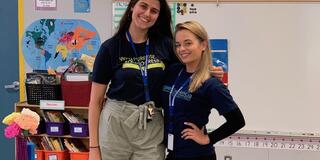To Students, with Love: Teaching in the Time of COVID-19

Spring break is a time students can’t wait for —family vacations, get-togethers with friends, and time to unwind a little. Across the Bay Area, however, spring break didn’t bring with it the usual excitement and anticipation.
Just a few weeks before Bay Area schools were scheduled to close for Spring Break, shelter-in-place orders were announced, leaving teachers and administrators scrambling to figure out remote learning and instruction.
Unsure and Unprepared
“As a school, we weren’t prepared. The first two weeks we were closed without providing any programming; then, the following two weeks was spring break,” recounts Shantá Krick-Gathright a special education teacher, and recent (2020) graduate of the Master of Arts in Special Education at USF, who works in Richmond California.
“We were one of the last schools in the Bay Area to shut down,” explains Michele Darchuck, a first-grade teacher in Redwood City, and a McGrath Scholar in the Catholic Education Leadership Doctoral Program at USF. “We were waiting as long as possible for our families and students who benefit from our extended school schedule. When the shelter-in-place was announced, we laid out instruction only up until spring break.”
At the start of the shelter-in-place order, teachers like Krick-Gathright and Darchuck were under the impression that schools would be closed until spring break ended. When it was announced that schools would remain closed for the rest of the year, they had to quickly reimagine what the rest of the year would look like in a remote environment.
What do I do now?
“I was already nervous and stressed, and when we received the news that schools would be closed for the rest of the academic year I thought, what should I do now? How do I teach first grade remotely?” says Darchuck.
Before spring break ended Darchuck and colleagues quickly worked out a plan to record and upload lessons onto Youtube, and have students submit homework through the school’s online portal. Despite the online system, Darchuck still believes in maintaining strong teacher-student relations. “I Zoom (video conference) or Facetime with each of my 28 students twice a week, and make myself available to parents via phone during the weekdays,” said Darchuck.
For Krick-Gathright the busy and complex workday of a special education teacher didn’t easily translate to a remote environment. “I’m in Zoom all-day long from 8:30 to 5 p.m.” she added. “Most of my students I see three or four times a week for 30-45 minute sessions. There are two that I see 5 days a week. Executing my work remotely is tough, but my students need individualized attention and support, especially as they adjust to using new technology and using it independently.”
One Team, One Family
As schools continue to stay closed, Darchuck and Krick-Gathright understand education becomes a shared responsibility.
“We have this saying at my school, ‘one team, one family’ — that has never been more true than now,” says Darchuck, who as a single mother, full-time teacher, and a graduate student, understands the challenge of balancing a family, work, and school during a pandemic. “I tell parents to do what’s best for your family. Health and safety come first. It’s what my USF professors have said to me and what I want to extend to my students and their parents.”
As students during this time, Darchuck and Krick-Gathright consider their faculty and peer community at USF as part of their family and team. “I started at USF and teaching at the same time,” remembers Krick-Gathright. “It was quite a learning curve then, and what I learned at USF has helped me so much along the way. Even now, my cohort and faculty members are sharing resources and helpful practices to get through this time together.”
To My Students
To this day, what Krick-Gathright and Darchuck have found most difficult about this experience is being apart from their students. “The reason why teachers teach is that we love being with kids,” says Darchuck. “The hardest part of this is not being with them. To all my students, I would say “You are so loved and I am blessed to be your teacher. I cannot wait to see you again and give you all hugs and hi-fives.”
“I miss my students so much,” says Krick-Gathright. She adds, “This process has been emotional for me, and a big part of it is knowing that they won’t be my students next year. I want my students to know that even though school looks different right now, I am so proud of them, inspired by them, and see their growth every day.”
Help support amazing Bay Area teachers like Shantá and Michele, by visiting giving at USF or by contacting Tina Burgelman, Director of Development.
Support is still needed in many areas as the situation continues to unfold worldwide. So we can continue to support our global USF community, consider giving to the COVID-19 Response Fund »


